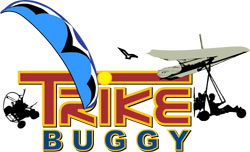

Ever dreamed of flying? Of course you have, that's why you're here! But what sensation do you feel when you fly? Is it seated inside of a cockpit with your hands on a steering wheel or joystick? Not exactly the most intuitive or realistic connection to controlling the wing. How about a bar? Hanging suspended from the wing and pushing around a bar in the opposite direction to where you want to go is not quite what you had in mind? Maybe there's another way... Meet the TrikeBuggy! With this simple PPG Trike, the control of the wing is as natural as a bird - dip your left arm like the wing on a bird, and your craft turns left! Look right and lower your right arm and you turn right. Level flight is done by having a relaxed, light touch of the hands on the toggles while the gentle flare needed to gently set the vehicle down is done by simply applying both brakes just as you approach the ground. Totally intuitive and completely natural feel compared with any other aircraft available today. What is a PPG Trike? A PPG Trike is simply a powered paraglider backpack motor unit mounted to a three or four wheeled foot steerable trike, using a standard paraglider wing to achieve flight. A PPG Trike is light, around 100 pounds including the motor and trike. Motor size is anywhere from 100cc to 325cc, and the backpack motor is removable for foot-launched flight as well (with the same wing). The Problem
Also, getting in and out of this design meant wiggling into your harness while it is attached to the trike. When launching, the wing picks you up by the harness, carrying the motor and finally, the trike along with it - changing and destabilizing the whole balance of the aircraft when going from taxi to flight. The front end literally falls away from your feet upon launching. There had to be a better way! The Solution The TrikeBuggy is an aircraft that is just big enough to carry the pilot and his gear, nothing more, nothing less. Unlike the PPC's that are massively overbuilt and overpowered, the TrikeBuggy is a personal aircraft. It has the power to climb as well as any good ultralight, and has the gliding performance to enjoy some quiet engine-off time.
Speaking of legal, many ultralight pilots are now looking for a way to continue the enjoyment of flying but are not interested in getting their Sport Pilot license to fly their heavier aircraft. With the TrikeBuggy, no license is needed, but a couple of days of good training and instruction will usually save money in rollover expenses. The TrikeBuggy is great for anyone that is concerned with trying to run out a launch in zero wind with a 60 lb. throbbing motor and spinning propeller on their back. With the TrikeBuggy, you simply sit down, fasten a seat belt and throttle into a taxi run while rolling on soft wheels made smooth with high-speed bearings. The takeoff can be done at full speed without the fear of falling down and risking injury. Landings are a breeze as well, since you can simply roll to a stop from touchdown, again at near full speed without concern. Gone are the days of dreading the landing in no wind, risking ankles, knees, props and cages. FOG's (Fine Old Guys) and women do well with the TrikeBuggy also, since it doesn't require one to be a bodybuilder to operate! Anyone with a prior injury, bad shoulder, weak knees or back problems can fly this aircraft all on their own.
Versatile? Remember that the TrikeBuggy is made from a kite buggy, so when the wind comes up too strong for flying, we can remove the PPG motor and break out the traction kites for some wind-driven fun! From the Beginning... When researching flying machines, consider all the options; ease of use, comfort, durability, versatility and sensation. The TrikeBuggy is simply the ultimate PPG Trike! |
|
|---|
|
DISCLAIMER: Please read and be sure you thoroughly understand this disclaimer before flying a TrikeBuggy. Trike flying is an extremely demanding sport requiring exceptional levels of attention, judgment, maturity and self discipline. It is unlikely that you will be able to participate in it safely unless you make a conscious and continual commitment to your own safety. PPG and Hang Glider Trike flying is a dangerous sport and may result in injury and death even when practiced by a competent pilot using proper equipment. TrikeBuggies are not covered by product liability insurance, nor have they been designed, manufactured or tested to any federal or state government airworthiness standards or regulations. Do not fly them unless you are willing to assume personally all risks in the sport of Trike flying, and all responsibility for any property damage, injury, or death which may result from your use of this TrikeBuggy. Safe operation of the TrikeBuggy requires a pilot proficiency equivalent to that of a BFI (Basic Flight Instructor), as well as an equivalent level of knowledge and understanding of those wind and weather conditions which may compromise the pilot's safe control of the TrikeBuggy. In particular, be advised that gusty winds or turbulent conditions may interfere with even an expert pilot's ability to safely control the TrikeBuggy, and may cause it to crash. Never take anything for granted in Trike Flying. If you are in doubt about anything, stop and figure it out or contact TrikeBuggy. Also please read our Warning and Caution! |